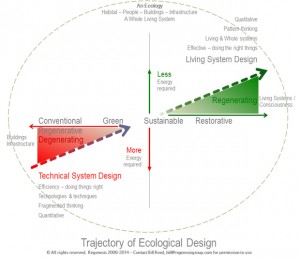The International Living Future Institute (ILFI) Net Positive Conference in San Francisco this February presented a vision for the environmental performance of buildings that is challenging for many to embrace. The idea of net-positive development, in which a building and its occupants consume less energy, food, clean air, and water than is collected or produced on site, is inherently challenging. In an industry that is still struggling to embrace net-zero energy, the notion that the built environment can be regenerative seems a world away.

After listening to the green building industry’s best and brightest minds, it seems the key barrier to broader adoption of net-positive development is the perception of it being infeasible or unattainable. An alternative perspective is that pursuing net-positive development is our only rational choice, since conventional building practices significantly degrade our quality of life over time. Incorporating toxic chemicals, using natural resources as if they are unlimited, and creating ever-growing piles of building waste is not sustainable. Our survival as a species literally depends on changing our approach.
“Pursuing net-positive development is
our only rational choice…”
The Living Building Challenge (LBC) is a green building standard that applies metrics for net-positive development by holistically addressing site, water, energy, materials, health, equity, and beauty. While the LBC may be seen as a niche certification that requires a firm commitment to sustainability, it is in fact achievable and offers an attractive triple bottom line. For this reason, the ‘challenge’ can be seen as an opportunity, rather a limitation. Often the ultimate barrier is changing how we view things, rather than advancing technology or refining economics. To help break down the perception of the LBC as a hindrance, we outlined three strategies that support a shift in perspectives and behaviors for a net-positive future.
Think Cyclically
The first step is to think cyclically. Every action has an equal and opposite reaction. Energy in equals energy out. At the beginning of design, it is essential to comprehend all the inputs of the system and the outputs they may create. For example, when a city taps a watershed for drinking water, the watershed should be recharged with water of similar quality as when it was extracted. Polluted, deoxygenated, hot water is not an equal exchange for clean, oxygenated, cold water. Incorporating this parameter changes the flow of inputs and outputs within that system. If at the end of a process you don’t start back at the beginning, try again. Close the loop.
Promote Diversity
The second step to achieving regeneration is to promote diversity. This means diversity within the design team, diversity of building products used, and diversity of engineered solutions. Life inherently thrives on diversity; it generates resilient, beautiful, and effective outcomes. More options mean more solutions. Any system, building, community, or ecosystem becomes stronger and more robust when it becomes more diverse. We can use this idea as an analogy for the design team. Imagine the input that one person with a single background can provide to a project versus the input from a group of people with various backgrounds. Undoubtedly, the latter provides a much stronger opportunity for holistic, multi-faceted, integrated, and effective design.
“Do the hard work of finding synergies and making connections between systems.”
Seek Integration
The third and most important step is to seek integration and do the hard work of finding synergies and making connections between systems. This applies to all parties. Everyone must be interconnected, yet accountable. Wouldn’t it be great to see power and water utilities both connecting to the same SmartGrid? Wouldn’t it be great if manufacturers based their business model on something other than the bare minimum required by code? Simply showing up is not enough. Embrace the challenge. Do the work.
By implementing these approaches with conscious awareness, net-positive solutions all of a sudden become achievable. At Glumac, we are passionate about sustainability and driving the dialogue on green buildings that work. This is why we are making investments to obtain building performance metrics (closing the loop), to engage regulatory agencies (diversifying the team), and to provide educational outreach within our local communities (seeking integration).
To join the conversation and find out more, write me at [email protected] or visit our Facebook, Twitter, and LinkedIn pages.

